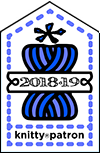Banrion, a free knitting pattern from Knitty.com. Free knitting pattern for a striped shawl with an asymmetrical cable.
INTRODUCTION
Banrion
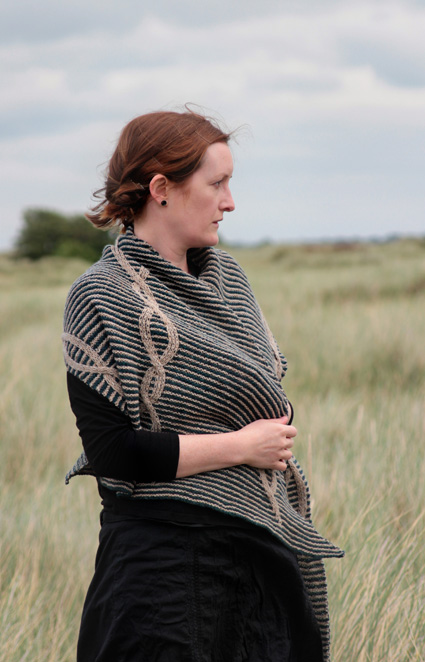 by Eimear Earley
by Eimear Earley
![]()
I'm a little obsessed with old things, and in particular, the surface decoration on very very old things. I have noticed that certain motifs appear over & over again, on seemingly unrelated artefacts. Banrion (meaning 'Queen') takes her name and inspiration from the Cavan or Queen's Brooch, discovered in County Cavan in Ireland. This brooch features panels of intricate interlacing knotwork, with simpler designs along curved areas of the brooch. It was these simpler designs that caught my knitterly eye; the simple twists scream 'KNITTED CABLES!'
Banrion is a triangular shawl featuring a ribbed cable motif, on a two-colour garter stitch background. The pattern begins by casting on just a few stitches, working in garter stitch stripes, and increasing the stitch count as the shawl progresses. The cables are introduced gradually as the shawl grows wider.
The ribbed cable motifs are a modern reinterpretation of classic cables, usually associated with warm & structured cabled aran sweaters. The combination of slipped stitches and ribbing creates a soft fabric suitable for a draping shawl.
The pattern is knit in Studio Donegal's Darnie, a 4-ply reinterpretation of classic Donegal Aran Tweed yarns.
For more examples of ancient art in Ireland, see the website of the National Museum of Ireland here. Other examples of Irish artefacts decorated with interlacing knotwork include the Ardagh Chalice, the Tara Brooch, the Ahenny High Crosses and the Book of Kells.
 model: Eimear Earley
model: Eimear Earley
 photos: Tom Cunningham
photos: Tom Cunningham
SIZE
One
FINISHED MEASUREMENTS
Depth at deepest point: 29.5 inches/75 cm
Length: 73 inches/ 185 cm
MATERIALS
Yarn
Studio Donegal Darnie [100% Lambswool; 448 yd/ 410 m per 100g skein];
![]() [MC] 8812; 1 skein
[MC] 8812; 1 skein
![]() [CC] 8804; 1 skein
[CC] 8804; 1 skein
Recommended needle size
[always use a needle size that gives you the gauge listed below - every knitter's gauge is unique]
![]() US #6/4mm needles for working flat.
US #6/4mm needles for working flat.
Notions
![]() cable needle
cable needle
![]() yarn needle
yarn needle
![]() stitch markers
stitch markers
GAUGE
22 sts/34 rows = 4 inches/10 cm in garter stitch
PATTERN NOTES
[Knitty's list of standard abbreviations and techniques can be found here.]
The pattern is worked in alternating 2-row stripes, and with an increased stitch every 4th row.
Cable stitches are worked in the main color only.
The pattern features slipped stitches. All stitches are slipped purlwise. When working a right side row, yarn is held to the back of the work. When working a wrong side row, yarn is held in front of the work.
3R RC (3 ribbed right cross): slip one stitch to cable needle and hold to back, k1, p1; k1 from cable needle.
5R RC (5 ribbed right cross): slip one stitch to cable needle and hold to back, [k1, p1] two times; k1 from cable needle.
7R RC (7 ribbed right cross): slip one stitch to cable needle and hold to back, [k1, p1] three times; k1 from cable needle.
7R LC (7 ribbed left cross): slip 6 stitches to cable needle and hold to front, k1, [k1, p1] three times from cable needle.
12 R LC (12 ribbed left cross): slip 6 stitches to cable needle and hold to front, [k1 p1] three times, [k1, p1] three times from cable needle.
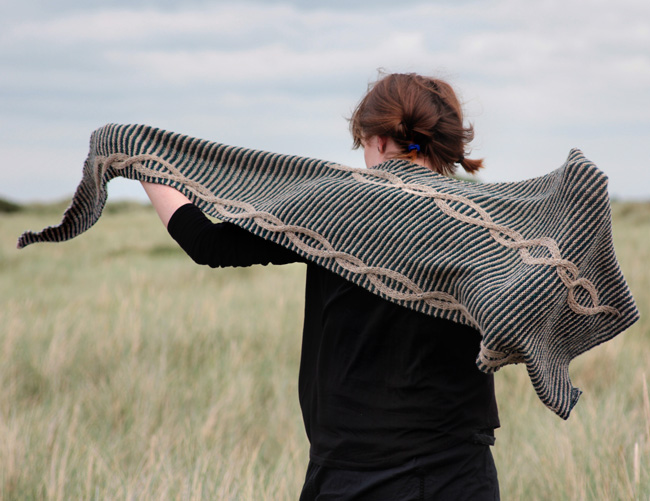
CHARTS
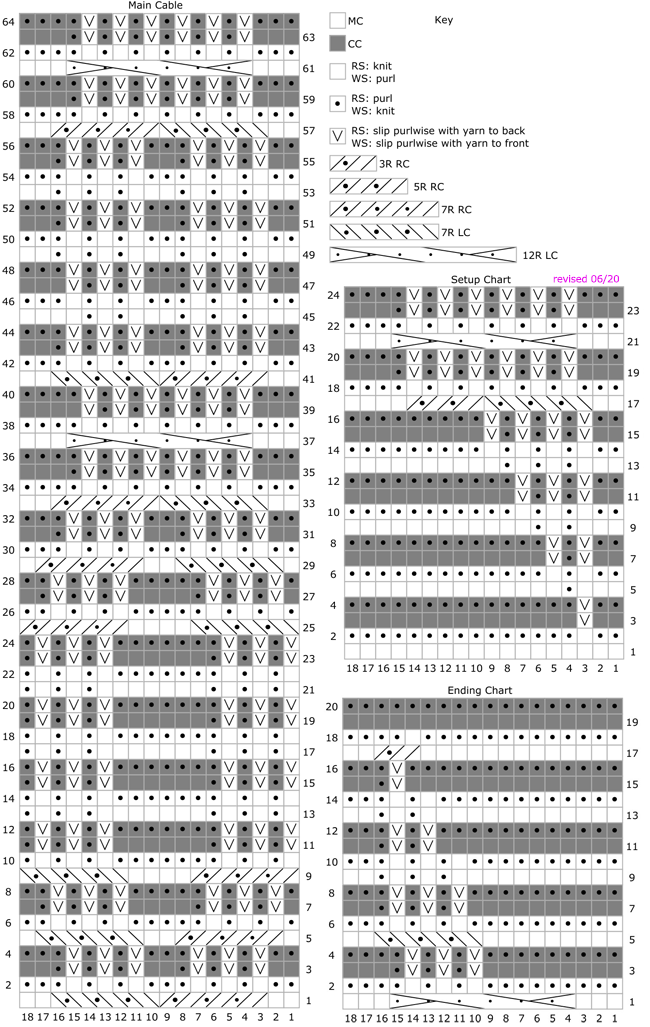
DIRECTIONS
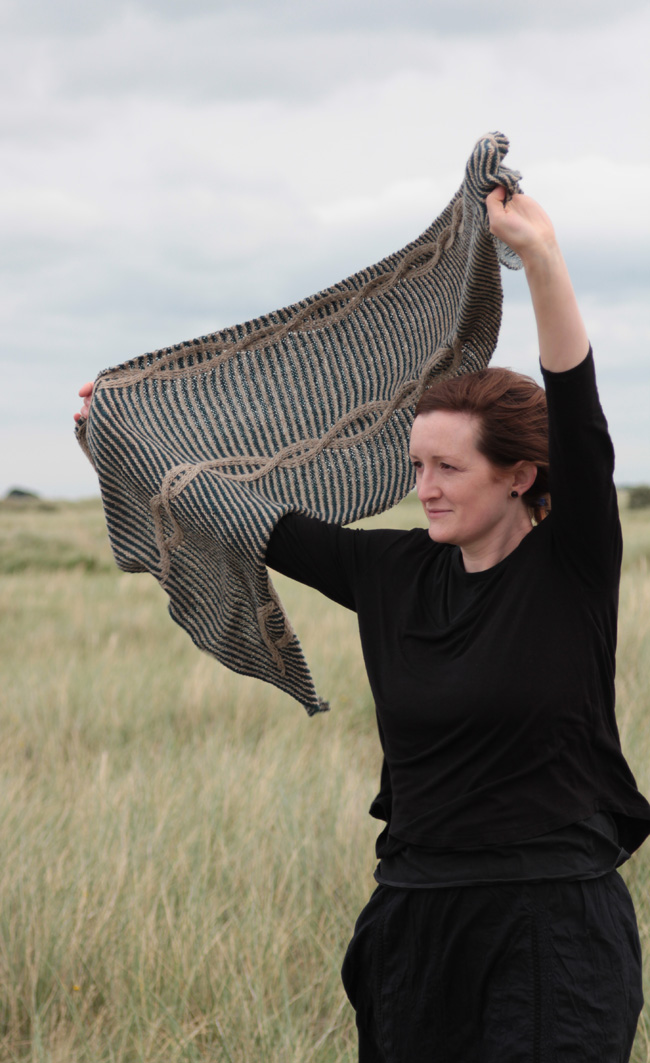
Using MC, cast on 3 sts.
Row 1 [RS]: K to last 2 sts, kfb, k1. 4 sts.
Row 2 [WS]: Knit.
Join CC, leaving MC attached. You will keep both yarns attached throughout.
Row 3: Using CC, knit.
Row 4: Using CC, k to end.
Repeat Rows 1-4 19 more times, and work rows 1-3 once more. 24 sts.
Final row, to setup for cables [WS]: Using CC, k3, pm, k18, pm, k3.
The markers divide off the Cable pattern placement. The rem sts either side are worked in garter stitch.
First Cable Setup:
Row 1 [RS]: Using MC, k to m, work Setup Chart, k to last 2 sts, kfb, k1. 1 st increased.
Row 2 [WS]: Using MC, k to m, work Setup Chart, k to end.
Row 3 [RS]: Using CC, k to m, work Setup Chart, k to end.
Row 4 [WS]: Using CC, k to m, work Setup Chart, k to end.
Repeat Rows 1-4 until you have completed Row 24 of the Setup Chart. 30 sts.
First Cable Continue:
Row 1 [RS]: Using MC, k to m, work Main Chart, k to last 2 sts, kfb, k1. 1 st increased.
Row 2 [WS]: Using MC, k to m, work Main Chart, k to end.
Row 3 [RS]: Using CC, k to m, work Main Chart, k to end.
Row 4 [WS]: Using CC, k to m, work Main Chart, k to end.
Repeat Rows 1-4 until you have worked all 64 rows of the Main chart twice, and Rows 1-40 once more. 72 sts.
Second Cable Setup:
Row 1 [RS]: Using MC, k to m, work Main Chart, k30, pm, work Setup Chart over 18 sts, pm, k to last 2 sts, kfb, k1. 1 st increased.
Row 2 [WS]: K to m, work Setup Chart, k to m, work Main Chart, k to end.
Row 3 [RS]: Using CC, k to m, work Main Chart, k to m, work Setup Chart, k to end.
Row 4 [WS]: Using CC, k to me, work Setup Chart, k to m, work Main Chart, k to end.
Repeat Rows 1-4 until you have completed Row 24 of the Setup Chart and Row 64 of the Main Chart. 78 sts.
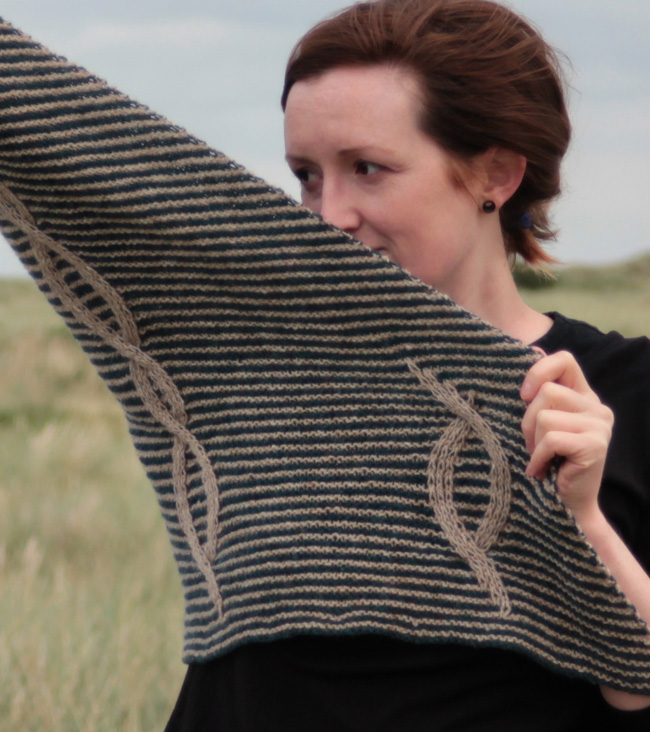
Continue:
Row 1 [RS]: Using MC, (k to m, work Main Chart) twice, k to last 2 sts, kfb, k1. 1 st increased.
Row 2 [WS]: Using MC, (k to m, work Main Chart) twice, k to end.
Row 3 [RS]: Using CC, (k to m, work Main Chart) twice, k to end.
Row 4 [WS]: Using CC, (k to m, work Main Chart) twice, k to end.
Repeat Rows 1-4 until you have worked all 64 rows of the Main chart twice, and Rows 1-40 once more. 120 sts.
Third Cable Setup:
Row 1 [RS]: Using MC, (k to m, work Main Chart) twice, k30, pm, work Setup Chart over 18 sts, pm, k to last 2 sts, kfb, k1. 1 st increased.
Row 2 [WS]: K to m, work Setup Chart, (k to m, work Main Chart) twice, k to end.
Row 3 [RS]: Using CC, (k to m, work Main Chart) twice, k to m, work Setup Chart, k to end.
Row 4 [WS]: Using CC, k to m, work Setup Chart, (k to m, work Main Chart) twice, k to end.
Repeat Rows 1-4 until you have completed Row 24 of the Setup Chart and Row 64 of the Main Chart. 126 sts
Continue:
Row 1 [RS]: Using MC, (k to m, work Main Chart) three times, k to last 2 sts, kfb, k1. 1 st increased.
Row 2 [WS]: Using MC, (k to m, work Main Chart) three times, k to end.
Row 3 [RS]: Using CC, (k to m, work Main Chart) three times, k to end.
Row 4 [WS]: Using CC, (k to m, work Main Chart) three times, k to end.
Repeat Rows 1-4 until you have completed Row 36 of the Main Chart. 135 sts.
Final Section:
Row 1 [RS]: Using MC, (k to m, work Ending Chart) three times, k to last 2 sts, kfb, k1. 1 st increased.
Row 2 [WS]: Using MC, (k to m, work Ending Chart) three times, k to end.
Row 3 [RS]: Using CC, (k to m, work Ending Chart) three times, k to end.
Row 4 [WS]: Using CC, (k to m, work Ending Chart) three times, k to end.
Repeat Rows 1-4 until you have completed Row 20 of the Ending Chart. 140 sts.
Row 1 [RS]: Using MC, k to last 2 sts, kfb, k1. 141 sts.
Row 2 [WS]: Using MC, knit.
Rows 3-4: Using CC, knit.
Row 5: Using MC, k to last 2 sts, kfb, k1. 142 sts.
Row 6: Using MC, knit.
Row 7: Using CC, knit.
Using CC, bind off knitwise.
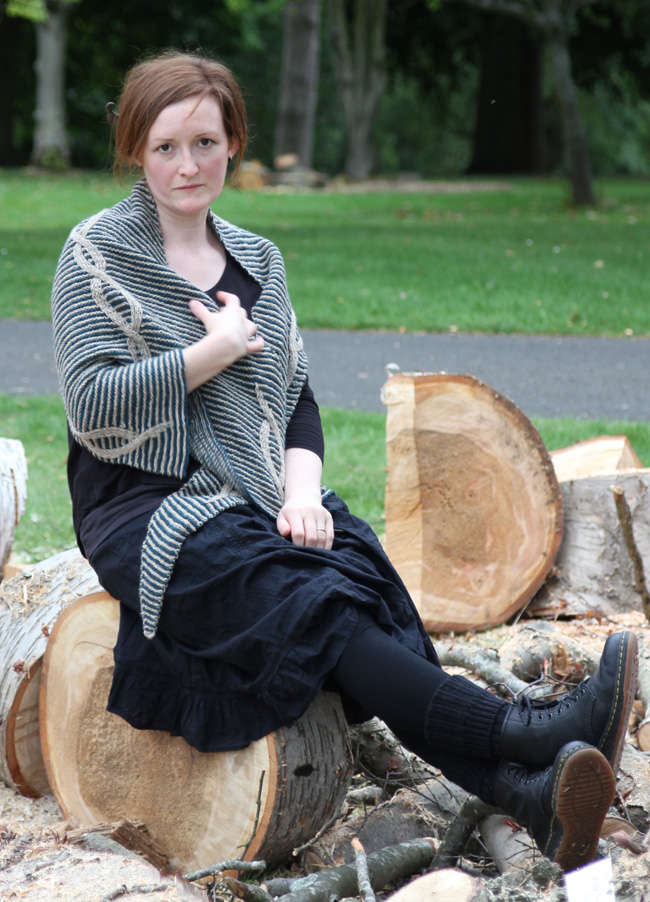
FINISHING
Weave in ends.
To block, soak shawl in warm water with a little wool-suitable detergent. Squeeze out excess water by rolling in towels.
Smooth out shawl on a level surface, stretch and pin into place. Allow to dry fully before removing pins.
ABOUT THE DESIGNER
 Eimear Earley spends most of her time taking care of two small humans. Formerly a craft design student who played with molten glass, she now gets her creative kicks from knitting & spinning wool – much more practical pursuits. Eimear is infatuated with prehistoric Irish gold artefacts, and is inspired by the notion of translating highly ornate ceremonial objects into everyday woollen items.
Eimear Earley spends most of her time taking care of two small humans. Formerly a craft design student who played with molten glass, she now gets her creative kicks from knitting & spinning wool – much more practical pursuits. Eimear is infatuated with prehistoric Irish gold artefacts, and is inspired by the notion of translating highly ornate ceremonial objects into everyday woollen items.
She lives in Ireland, and also likes to drink an awful lot of tea.
Eimear can be found on Instagram and Ravelry.
Pattern & images © 2018 Eimear Earley.




